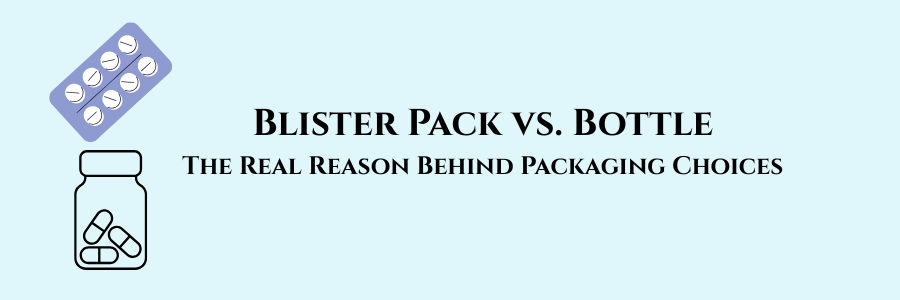Ever wondered why some medicines come in blisters while others are in bottles? It’s not just about cost or convenience—there’s a lot more behind these decisions!
1. RLD (Reference Listed Drug) – The Hidden Decision Maker
When a generic drug is developed, it must match the Reference Listed Drug (RLD), including its packaging. If the original drug was sold in blisters, generics typically follow suit for stability and regulatory compliance.
Example: If an anti-hypertensive drug’s RLD is packed in aluminum blisters, its generic version will also be packed similarly unless stability studies prove bottles work just as well.
2. Stability – The Biggest Factor
Many drugs degrade when exposed to moisture, oxygen, or light—issues that bottles struggle to prevent. Blister packs provide an air-tight seal, offering better protection.
- Moisture-sensitive drugs (e.g., Montelukast) dissolve in humidity.
- Oxygen-sensitive drugs (e.g., Aspirin) degrade when exposed to air.
- Light-sensitive drugs (e.g., Pantoprazole) require aluminum foil for stability.
Why Not Air-Tight Bottles? Even with desiccants (moisture-absorbing packets), every time a bottle is opened, it exposes the medicine to external conditions. Blister packs eliminate this risk entirely.
3. Dosage Accuracy & Patient Compliance
Blisters improve medication tracking and adherence, especially for:
- Birth control pills – Day-wise marking prevents missed doses.
- Antibiotics – Blisters ensure completion of the full course.
- Psychiatric drugs – Reduces overdose risk compared to bottles.
Did You Know? Studies show patient compliance is higher when medicines are in unit-dose blisters instead of bottles.
4. Cost & Production – Not Always What You Think
Many assume bottles are cheaper, but blisters offer key benefits:
- Less wastage – If one tablet gets damaged, others stay intact.
- Extended shelf life – No need for costly preservatives.
- Tamper-proof safety – Easily detects if a tablet is missing.
However, bottles make sense for:
- High-volume medicines (e.g., paracetamol) – Cheaper for bulk supply.
- Frequent-dosing meds (e.g., multivitamins) – Easy access without peeling foil daily.
5. The “Feel Factor” – Does Packaging Influence Trust?
Would you trust a medicine more if it came in a blister pack rather than a bottle? Many high-end medications use blisters for a “premium” feel and added security.
Some argue this is just psychological, while others say it genuinely improves shelf life and safety.
Read also:
Resource Person: Dev Soni

